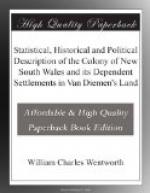The management of sheep is in some respects different. They are never permitted to roam during the night, on account of the native dog, which is a great enemy to them, and sometimes during the day, makes great ravages among them, even under the eye of the shepherd. In every part of the country, therefore, they are kept by night either in folds or yards. In the former case the shepherd sleeps in a small moveable box, which is shifted with the folds, and with his faithful dog, affords a sufficient protection for his flock, against the attempts of these midnight depredators. In the latter the paling of the yards is always made so high, that the native dog cannot surmount it; and the safety of the flock is still further ensured by the contiguity of the shepherd’s house, and the numerous dogs with which he is always provided.
The natural grasses of the colony are sufficiently good and nutritious at all seasons of the year, for the support of every description of stock, where there is an adequate tract of country for them to range over. But in consequence of the complete occupation of the districts which are in the more immediate vicinity of Port Jackson, and from the settlers in general possessing more stock than their lands are capable of maintaining, the raising of artificial food for the winter months, has of late years become very general among such of them as are unwilling to send their flocks and herds into the uninhabited parts in the interior. This is a practice which must necessarily gain ground; since it has been observed, that the coldness of the climate keeps pace with the progress of agriculture. In the more contiguous and cultivated districts, the natural grass becomes consequently every year more affected by the influence of frost, and the necessity of raising some artificial substitute for the support of stock, during the suspension of vegetation, more pressing and incumbent. It is from this increase in the severity of the winters, that the custom of making hay has begun to be adopted; and should the future augmentation of cold be, as there is every reason to believe, proportionate to the past, this custom will, before the expiration of many years, become generally prevalent. It is indeed, rather a matter of surprise than otherwise, that so salutary a precaution has been so long in disuse; since such is the luxuriance of the natural grass during the summer, that it is the general practice after the seeds wither away, to set fire to it, and thus improvidently consume what, if mown and made into hay, would afford the farmer a sufficiency of nutritious food for his stock during the winter, and altogether supersede the subsequent necessity for his having recourse to artificial means of remedying so palpable a neglect of the bounteous gifts of nature.




